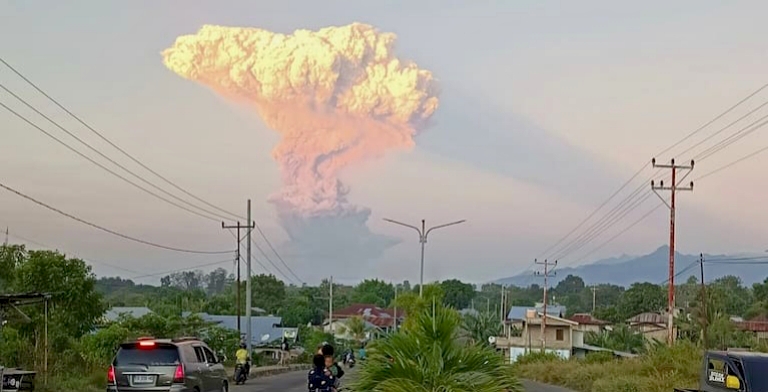
Lewotobi Laki-laki Volcano in Indonesia Erupts, Triggers Highest Alert Level

 :
| Updated On: 18-Jun-2025 @ 11:42 am
:
| Updated On: 18-Jun-2025 @ 11:42 amSHARE
Mount Lewotobi Laki-laki, a volcano in south-central Indonesia, erupted on Tuesday, sending towering columns of hot ash up to 10,000 metres (32,800 feet) into the sky. This eruption prompted the Indonesian authorities to raise the alert level to the highest status and expand the designated danger zone around the volcano to 8km (5 miles) from the crater. The eruption produced a massive, mushroom-shaped cloud of grey ash that was visible from cities located between 90 to 150 kilometers (56 to 93 miles) away from the mountain.
The Indonesian Geological Agency confirmed the eruption occurred on Tuesday afternoon and described it as a powerful emission of thick volcanic ash. Despite the magnitude of the eruption, there were no immediate reports of damage, casualties, or flight cancellations. However, authorities warned local residents to remain vigilant, particularly in relation to the risk of lava flows that could be triggered by heavy rainfall and potentially flow through rivers that originate from the volcano’s slopes.
Mount Lewotobi Laki-laki, standing at 1,584 metres (5,197 feet), is part of a twin volcano system along with Mount Lewotobi Perempuan, located in the Flores Timur district. The volcano pair is named after Indonesian gender terms — “Laki-laki” means “man,” and “Perempuan” means “woman.” The twin volcanoes have erupted previously, including a deadly eruption in November that killed nine people and injured dozens.
Indonesia is no stranger to volcanic activity due to its location along the Pacific “Ring of Fire,” a geologically active zone marked by frequent earthquakes and volcanic eruptions. The country, made up of more than 17,000 islands and home to approximately 270 million people, has 120 active volcanoes — the most of any nation. These volcanoes pose ongoing risks to both rural communities and urban centers across the archipelago.
This recent eruption follows other notable volcanic activity in Indonesia. On October 27, Mount Marapi in West Sumatra — one of the country’s most active volcanoes — also erupted, further highlighting the volatility of Indonesia’s geological landscape. The recurring volcanic events underscore the country’s need for constant monitoring, public preparedness, and swift disaster response mechanisms.
Though no flight disruptions were reported after the Mount Lewotobi Laki-laki eruption, the scale and visibility of the ash cloud have raised concern among regional aviation authorities. In previous instances, such ash clouds have caused significant delays and even airport closures due to the risk posed to aircraft engines.
The government continues to monitor the situation closely, with geological agencies conducting ongoing surveillance of seismic activity and ash dispersion. Residents within and around the 8km danger zone have been advised to evacuate if necessary and follow safety instructions from local officials.
In summary, the eruption of Mount Lewotobi Laki-laki is a significant event in Indonesia’s ongoing volcanic history. While the immediate impact has been relatively contained with no loss of life or infrastructure damage reported, the potential for further eruptions or secondary hazards like lava flows remains a serious concern. Authorities remain on high alert to ensure public safety and minimize risks associated with future volcanic activity.
Contact Us
House. No. : 163, Second Floor Haridev Rd, near Puberun Path, Hatigaon,Guwahati, Assam 781038.
E-mail : assaminkcontact@gmail.com
Contact : +91 8811887662
Enquiry
×
Reporter Login
×